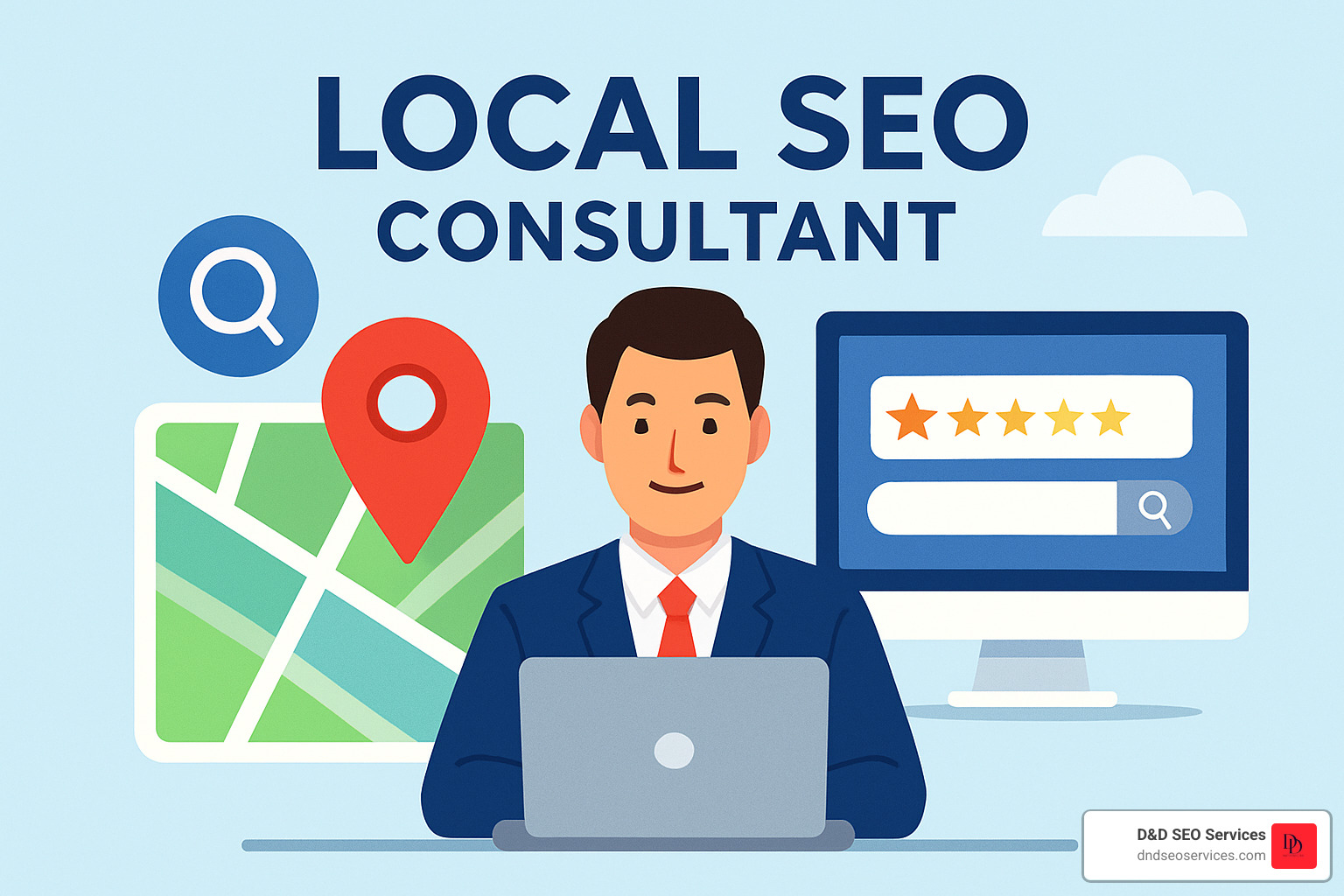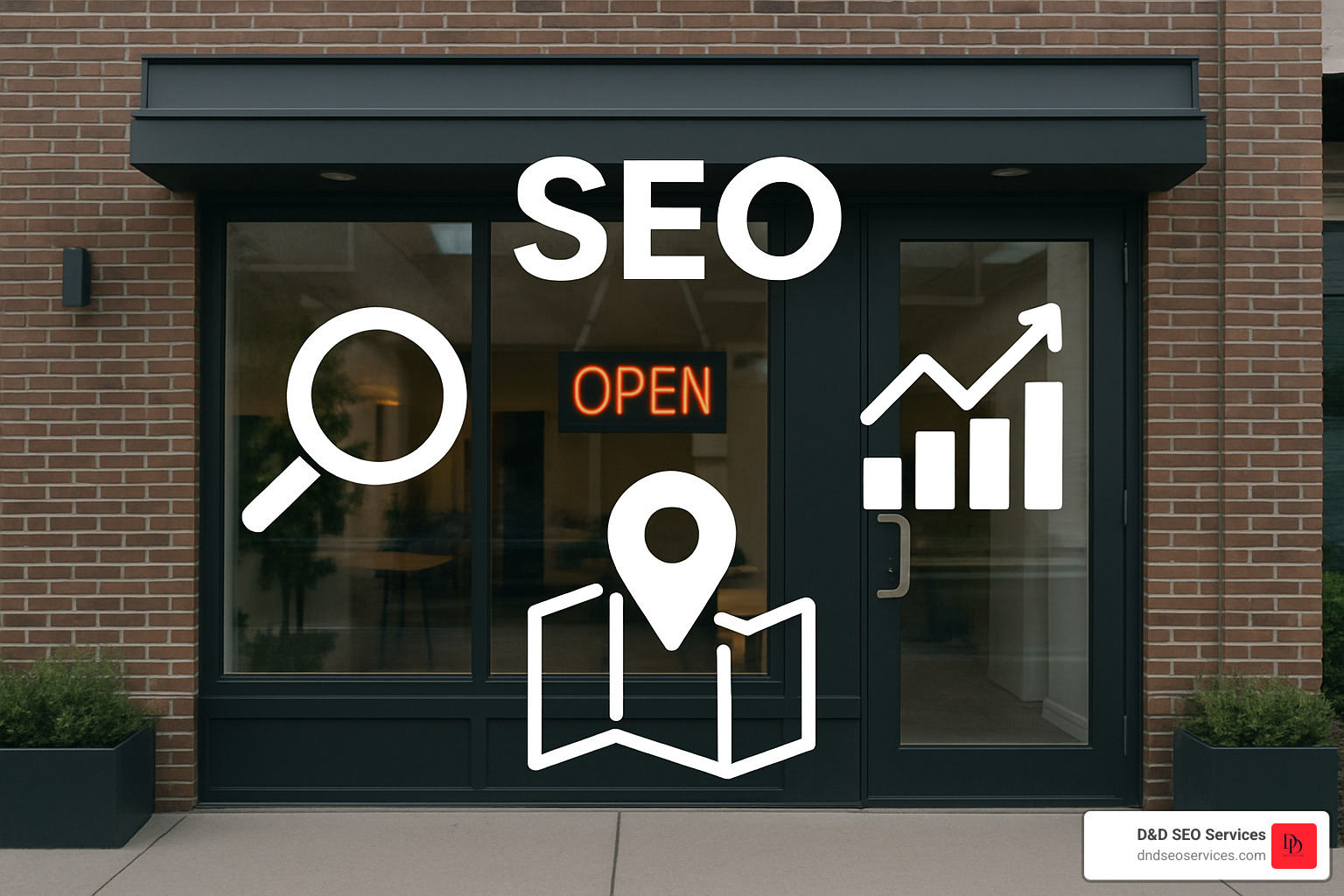The Importance of Local SEO for Businesses with Multiple Locations
When running a business with multiple locations, mastering a local SEO strategy for multiple locations is essential to reaching your audience. This approach helps each branch of your business stand out in local searches, driving traffic and increasing sales.
Quick Answer: To master local SEO for multiple locations:
1. Create unique pages for each location.
2. Optimize each page with location-specific keywords, meta titles, and descriptions.
3. Claim and manage Google Business Profiles for each location.
4. Build local backlinks and manage reviews.
5. Ensure NAP consistency across all citations.
Local SEO makes your business visible to people searching for your services in specific areas. If someone searches for “coffee shop near me,” you want your café to appear in the top results. This can greatly influence local foot traffic and customer engagement.
However, managing local SEO for businesses with multiple locations can seem daunting. Different places mean different customer needs, competition, and search queries. This is where D&D SEO Services steps in. We specialize in crafting tailored local SEO strategies that make your business visible and accessible to local customers, no matter how many locations you have.
Creating Location-Specific Pages
Optimizing Each Location Page
When it comes to local SEO strategy for multiple locations, the key is to create and optimize separate pages for each location. This ensures that each page can rank well for local searches in its specific area.
1. Separate Pages with Unique URLs
Each location should have its own dedicated page. This is essential for targeting local keywords and providing relevant information to users. A logical URL structure helps search engines understand the hierarchy and relevance of your pages. For instance, use URLs like:
www.mybusiness.com/locations/new-yorkwww.mybusiness.com/locations/los-angeles
2. Location-Specific Content
Content should be tailored to each location. This includes addressing local customer needs, highlighting services available at that location, and mentioning local landmarks or events. For example, a bakery in Dallas might mention nearby attractions like the Dallas Arboretum.
3. Local Keywords
Incorporate location-specific keywords throughout the content. This means using phrases like “best plumber in Dallas” or “HVAC repair company Los Angeles.” These keywords should appear naturally in headings, meta titles, and body content.
4. Meta Titles and Descriptions
Meta titles and descriptions are crucial for local SEO. They should include both the primary keyword and the location. For example:
- Meta Title: Best Cleaning Service in Dallas | My Business
- Meta Description: My Business provides top-notch cleaning services in Dallas, including Richardson, Addison, and Garland. Contact us today!
5. Structured Data and Schema Markup
Adding structured data helps search engines understand the content of your pages better. Use Schema Markup to provide detailed information about your locations. This includes business name, address, phone number, and opening hours. Proper schema markup can improve your chances of appearing in local search results and rich snippets.
6. Consistent NAP
Ensure that your Name, Address, and Phone number (NAP) are consistent across all pages and listings. Inconsistent information can confuse search engines and harm your rankings.
By following these steps, you can effectively optimize each location page for better visibility in local searches. Next, let’s dive into how to optimize your Google Business Profile for multiple locations.
Google Business Profile Optimization
Managing Google Business Profiles
Managing Google Business Profiles (GBP) for multiple locations can be a game-changer for local SEO. Here’s how you can optimize each profile to enhance your local search visibility:
Claiming Profiles
First, you need to claim or create a Google Business Profile for each of your locations. If profiles already exist, follow Google’s steps to claim them. For new profiles, you can add up to 9 locations manually or use the bulk upload feature for 10 or more locations.
Optimizing Profiles
Once you’ve claimed or created your profiles, optimization is key. Here are the essential steps:
- Consistent NAP: Ensure that your Name, Address, and Phone number (NAP) are consistent across all profiles and other online listings. Inconsistent NAP can confuse search engines and hurt your rankings.
- Business Hours: Accurately list the hours of operation for each location. This helps customers know when to visit and improves your credibility.
- Contact Information: Provide specific contact information for each location. Avoid using a central office number.
- Categories: Select the most specific primary category that fits your business. This helps Google understand what your business offers.
Adding Photos
High-quality images can make your profiles more appealing. Include:
- Logo: Your business logo for brand recognition.
- Cover Photo: A compelling cover photo that represents your business.
- Exterior and Interior Photos: Show the exterior and interior of each location to help customers recognize your business.
- Team Photos: Pictures of your team at work to build trust and connection with customers.
Responding to Reviews
Reviews play a crucial role in local SEO. Google looks at review factors like the number of reviews, keywords in reviews, and the mix of positive and negative reviews.
- Encourage Reviews: Ask satisfied customers to leave reviews and mention your location. For example, “Best gluten-free bakery in Frisco!”
- Respond to Reviews: Reply to both positive and negative reviews. Use local keywords naturally in your responses to help with SEO. For instance, “We’re so glad you enjoyed our gluten-free bakery in Frisco!”
Utilizing Google Posts
Google Posts allow you to share updates, offers, and news directly on your GBP. This keeps your profile fresh and engaging. Regularly update your posts to signal to Google that your business is active.
By effectively managing and optimizing your Google Business Profiles, you can significantly improve your local search visibility and attract more customers to each of your locations.
Next, let’s explore how to build local backlinks to further enhance your SEO strategy.
Building Local Backlinks
Building local backlinks is crucial for any local SEO strategy for multiple locations. Backlinks from local sources signal to search engines that your business is trustworthy and authoritative in your area. Here’s how to get started.
Join the Local Chamber of Commerce
Becoming a member of your local Chamber of Commerce is an excellent way to gain credibility and secure a valuable backlink. Chambers often feature member businesses on their websites, providing a high-quality link back to your site. For instance, a cleaning service in Lubbock might get listed on the Lubbock Chamber of Commerce website, boosting its local SEO.
Sponsor Local Events
Sponsoring local events can also generate backlinks and elevate your community presence. When you sponsor a local charity run or a school event, your business name is often featured on the event’s website. This not only drives traffic but also builds trust within the community. For example, an HVAC service sponsoring a local fair can get a backlink from the event’s homepage, enhancing its local search rankings.
Form Local Partnerships
Partnering with other local businesses for cross-promotion can be mutually beneficial. For example, a bakery could partner with a nearby coffee shop to offer joint promotions. These partnerships often lead to mentions and backlinks on each other’s websites. This strategy helps both businesses rank higher in local searches.
Write Guest Posts
Guest posting on local blogs and news sites is another way to build local backlinks. Write articles on topics relevant to your business and community. For example, a plumbing company could write a guest post on a local home improvement blog about “Winter Plumbing Tips for [City Name].” This not only provides valuable information but also includes a backlink to the plumbing company’s website.
Get Featured in Local Press
Securing features in local press can significantly boost your local SEO. Reach out to local newspapers, radio stations, and online news portals to share newsworthy stories about your business. For instance, a restaurant launching a new menu could get a feature in the local newspaper, complete with a backlink to its website. This not only improves SEO but also attracts local customers.
Attend and Network at Local Events
Networking at local events can also lead to backlinks. When you attend industry conferences, trade shows, or community gatherings, you build relationships that can result in mentions on other local business websites. These mentions often come with backlinks, adding to your local SEO efforts.
By focusing on these strategies, you can build a strong portfolio of local backlinks that enhance your local SEO strategy for multiple locations. These backlinks not only improve your search engine rankings but also establish your business as a trusted community member.
Next, let’s dive into managing reviews and reputation to further bolster your local SEO.
Managing Reviews and Reputation
Reviews are crucial for local SEO, especially for businesses with multiple locations. They can influence search rankings and customer decisions. Here’s how to manage and leverage reviews effectively.
Importance of Reviews
Positive reviews can boost your search rankings and attract more customers. According to a study, 93% of consumers read online reviews before making a purchase. For multi-location businesses, this means each location needs its own positive reviews to rank well locally.
Responding to Reviews
Responding to reviews shows that you care about customer feedback. This can improve your business reputation and customer loyalty. Here are some tips:
- Respond Quickly: A quick response shows that you value customer feedback.
- Be Professional: Always maintain a professional tone, especially when addressing negative reviews.
- Acknowledge Issues: If a customer had a bad experience, acknowledge their concerns and offer a solution.
Example:
Customer Review: “The service at the downtown location was slow.”
Your Response: “We apologize for the slow service at our downtown location. We’re addressing this issue to improve. Thank you for your feedback!”
Encouraging Reviews
Getting more reviews can be challenging, but it’s essential for your local SEO strategy for multiple locations. Here are some effective ways:
- Ask for Reviews: Don’t hesitate to ask happy customers to leave a review. You can do this in person, via email, or on receipts.
- Make It Easy: Provide direct links to your Google Business Profile or other review platforms.
- Offer Incentives: Consider offering a small discount or entry into a giveaway for leaving a review. Just ensure it complies with platform guidelines.
Example:
Print a message on receipts: “Enjoyed your visit? Leave us a review on Google!”
Review Management Strategies
Managing reviews across multiple locations can be overwhelming. Here are some strategies to streamline the process:
- Use Tools: Tools like Synup and BrightLocal can help you track and manage reviews from multiple locations in one place.
- Monitor Regularly: Assign someone to regularly check and respond to reviews.
- Highlight Reviews: Showcase positive reviews on your website and social media to build trust.
Pro Tip: Use structured data to mark up reviews on your website. This can help your star ratings appear in search results, enhancing your visibility.
By focusing on managing reviews and reputation, you can improve your local search rankings and build trust with potential customers. Next, let’s discuss the importance of ensuring NAP consistency across all listings.
Ensuring NAP Consistency
NAP consistency is crucial for your local SEO strategy for multiple locations. NAP stands for Name, Address, and Phone number. Ensuring that this information is consistent across all online platforms helps build trust with both Google and potential customers.
Why NAP Consistency Matters
Trust Factor: Google values accurate and consistent information. If your NAP details are mismatched, it makes your business seem less credible. According to Moz, NAP consistency is one of the most important aspects of Local SEO.
Avoids Search Confusion: If your address is listed differently on various websites, Google might not understand that it represents the same business. This can dilute your online authority.
Customer Experience: Inconsistent NAP leads to a frustrating experience for customers trying to find or contact you.
Where to Ensure NAP Consistency
Your Website: Your NAP should be prominently displayed, usually in the footer or on a contact page.
Google Business Profile: The accuracy of this listing is paramount.
Local Directories: Sites like Yelp, Yellow Pages, and industry-specific directories.
Social Media Profiles: Update NAP info across all your social platforms.
How to Audit and Fix Your NAP
Gather Your Variations: Search for your business online and make a list of every variation of your NAP that exists.
Prioritize Key Listings: Start with correcting mismatches on Google Business Profile, your website, and the most important local directories.
Use a Tool: Services like SEMrush’s Listing Management Tool can help automate citation management and monitor for new NAP inconsistencies. This tool searches the web for your business listings and evaluates how accurate they are, making it easier to identify and fix issues.
Online Directories and Citation Tracking
Citation Tracking: Keeping track of all the places your business is mentioned online can be overwhelming. Citation tracking tools like SEMrush’s Listing Management Tool or Moz Local can help. These tools search for your business listings and identify any inconsistencies.
Fixing Inconsistencies: Once you identify inconsistencies, correct them. This might involve updating your information on various platforms manually or using a tool to automate the process.
By ensuring NAP consistency, you can improve your local search rankings and provide a better experience for your customers. Next, let’s dive into some frequently asked questions about local SEO strategy for multiple locations.
Frequently Asked Questions about Local SEO Strategy for Multiple Locations
How do I optimize local SEO for multiple locations?
Optimizing local SEO for multiple locations involves several key steps:
- Create Location-Specific Pages: Each location should have its own dedicated page on your website. Include unique URLs, local keywords, and specific content for each location.
- Optimize Google Business Profiles: Have a separate Google Business Profile (GBP) for each location. Ensure all details like business hours, contact info, and images are accurate and specific to each location.
- Consistent NAP Information: Ensure that your Name, Address, and Phone number (NAP) are consistent across all platforms and directories.
- Build Local Backlinks: Engage with local businesses, participate in community events, and get listed in local directories to build valuable backlinks.
- Manage Reviews: Encourage customers to leave reviews and respond to them promptly. Positive reviews can boost your local SEO significantly.
- Use Schema Markup: Implement structured data to help search engines understand your location-specific information better.
How do I target multiple cities with SEO?
To target multiple cities with SEO, follow these steps:
- Location-Specific Content: Create content tailored to each city. Mention local landmarks, events, and other city-specific details.
- Separate Pages for Each City: Just like with multiple locations, create separate pages for each city you want to target. Use URLs like
mysite.com/locations/newyorkandmysite.com/locations/chicago. - Local Keywords: Use keywords that include the city name. For example, if you’re a dentist, use “dentist in New York” or “Chicago dental services.”
- Google Business Profiles: Set up and optimize a Google Business Profile for each city.
- Local Backlinks: Get backlinks from local websites, newspapers, and blogs in each city.
- Engage with Local Communities: Participate in local events and sponsor local organizations. This helps build your presence and generates local backlinks.
What is multi-location SEO?
Multi-location SEO is the practice of applying local SEO strategies to multiple business locations. It ensures that each location appears in local search results relevant to its specific area. This involves:
- Creating Location-Specific Pages: Each location should have its own dedicated page with unique content and local keywords.
- Optimizing Google Business Profiles: Each location needs its own Google Business Profile with accurate details.
- Consistent NAP Information: Maintaining consistency in your business name, address, and phone number across all online platforms.
- Building Local Backlinks: Engaging with local communities and getting listed in local directories to build backlinks.
- Managing Reviews: Encouraging and responding to reviews for each location.
By following these strategies, you can effectively manage and optimize your local SEO for multiple locations, ensuring that each one ranks well in local searches.
Next, we’ll conclude with a recap of the strategies and the importance of personalized approaches in local SEO. By implementing effective SEO strategies for local businesses, companies can enhance their visibility and attract more customers from their immediate area. It’s essential to tailor these strategies to meet the unique needs of the local community, ensuring that they resonate with potential clients. In this way, businesses can build stronger connections and foster loyalty within their target market.
Conclusion
Let’s recap the key strategies for mastering local SEO strategy for multiple locations:
- Creating Location-Specific Pages: Develop unique pages for each location with tailored content and local keywords.
- Optimizing Each Location Page: Use location-specific keywords, meta titles, and meta descriptions. Implement structured data and schema markup.
- Google Business Profile Optimization: Ensure each location has a consistent name, address, and phone number (NAP). Add images and business hours.
- Building Local Backlinks: Engage with local communities and get listed in local directories to build backlinks.
- Managing Reviews: Encourage and respond to reviews for each location.
- Ensuring NAP Consistency: Maintain consistent NAP information across all online platforms.
The importance of local SEO cannot be overstated. It ensures your business appears in relevant local searches, driving more traffic and conversions.
Each location has its own unique audience and market conditions. Therefore, a personalized strategy for each location is essential. Tailoring your content, keywords, and engagement efforts to fit the local context will help you stand out from competitors.
At D&D SEO Services, we specialize in creating and implementing effective local SEO strategies for businesses with multiple locations. Our goal is to help you achieve higher visibility and engagement in each of your target markets.
Ready to take your local SEO to the next level? Learn more about our local SEO services and let’s get started on optimizing your business for success. Our expert team will work closely with you to implement effective local SEO strategies for businesses, ensuring that you stand out in your community. By targeting the right keywords and enhancing your online presence, we can help drive more traffic to your site and increase conversions. Together, we’ll create a tailored approach that meets the unique needs of your brand.
By following these strategies and leveraging expert assistance, you can ensure that each of your locations ranks well in local searches, driving more traffic and increasing your bottom line.









